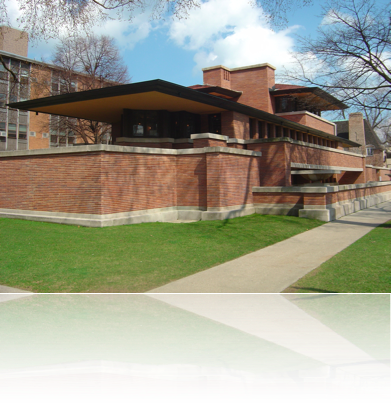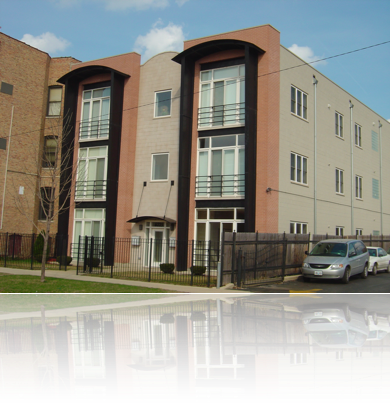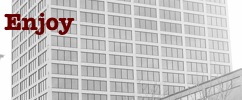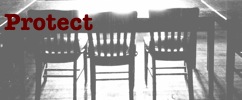
A Short History
Chicago has been known as a center of architectural style and innovation for well over a hundred years. While most of the city’s fame comes from the downtown skyscrapers of the early to middle 20th century, the South Side is home to many of Chicago’s architectural landmarks.
Like any 19th century boomtown, Chicago’s homes were built in a hodgepodge of styles and designs. Buildings in Queen Anne, Gothic Revival, Tudor, Classical, Prairie, and Arts and Crafts styles appeared side by side. The fire of 1871 marked Chicago architecture profoundly, as building code changes forbade the use of wood frame houses within what was known as the “fire limits.” As a result, brick and stone dominate the city’s neighborhoods. A rare exception can be found in Hyde Park, where a block of frame houses built before Hyde Park was annexed to the city still stands largely intact on Blackstone Avenue between 54th and 55th Streets and others on Kenwood Avenue between 55th and 56th Streets.
Hyde Park is also home to the University of Chicago campus. While the University has added some prominent modern buildings in recent years (Ricardo Legorreta’s Max Palevsky dorms, Rafael Vinoly Architects’ Graduate School of Business, and Cesar Pelli’s Ratner Athletic Center most notably), it is still primarily known as an example of Gothic Revival architecture, characterized by the main quads built between 1892 and about 1930. Just off campus sits Frank Lloyd Wright’s Robie House, a classic of the Prairie Style built in 1910.
Beginning with the construction of the 98-unit Mecca Flats in 1891 and continuing for several decades, large-scale apartment buildings sprang up across the South Side. Home ownership was not an immediate prospect for most of the city’s burgeoning working class, and large apartment buildings were an efficient, if controversial way to provide housing for them. Deep courtyards and bay windows were often used to provide light and open space to the residents and many of the buildings feature beautiful exterior detail work. To the west of Hyde Park, in Bridgeport, Englewood, and the neighborhoods to the city’s southwest, residential areas include many typical Chicago bungalows. These one-story single-family houses offered Chicagoans of relatively modest means the chance to own a home away from the overcrowding of the south lakeshore’s transit corridors.
Hyde Park was also an early center of the architectural styles associated with urban renewal in the 1950’s and 60’s (see Housing). The stolid development between 55th and 57th streets east of Dorchester is typical of this guarded and protective style. Traffic patterns were disrupted and rerouted, notably by the massive I.M. Pei-designed towers in the middle of 55th street, in an attempt to restrict access to Hyde Park from the neighborhoods around it.
The 1950’s and 60’s saw two other modernist developments on the South Side, one famous and the other infamous. Ludwig Mies van der Rohe served as the head of the Illinois Institute of Technology’s architecture program from 1938 to 1958, designing much of the school’s campus in that time. While Mies’ stark modernist style is hotly debated still today, IIT has used it as a reference for its remarkable newer buildings. Much of the south lakeshore’s urban renewal-era high-rise housing dates from this same period and represents a similarly sleek, steel-and-glass style.
Skirting IIT to the west and running as far south as Garfield Boulevard, the Stateway Gardens and Robert Taylor Homes made perhaps the definitive architectural mark on the South Side. While Mies was turning the Institute into a landmark of modernist style, Chicago was grappling with the question of how to manage the massive growth of the African American population and the white hostility to integration that accompanied it. One result was the massive complex stretching some 20 blocks along South State Street from 35th to Garfield Boulevard. These huge multi-story apartment buildings of Stateway Gardens and the Robert Taylor Homes were conceived along the urban utopian designs of Le Courbusier: open galleries on each floor, large swathes of neutral space or parkland between buildings, and large-scale transit infrastructure connecting the housing blocks to the rest of the city. By the 1980’s, however, graft, neglect, and mismanagement had made Stateway and the Taylor Homes into a byword for urban decay and the failure of public housing—a far cry from the progressive vision of Le Corbusier and his American disciples. In the 1990’s, the city began demolishing Stateway and the Taylor Homes. Today none buildings still stand, and one of those is unoccupied.
Today the residential architecture of the South Side is being marked most prominently by gentrification and redevelopment, as empty lots are filled with townhouses and condominiums of varying design and quality. Redevelopment is preserving some venerable old buildings that had fallen into disrepair while destroying others. The multi-unit apartment buildings that sprang up in the 1910’s and 20’s are no longer being built, and with public housing disappearing and being replaced at a very low rate, some South Side residents are finding themselves priced out of the neighborhoods they’ve lived in for their whole lives.
Further Reading:
“Chicago Historic Resources Survey” (Chicago: City of Chicago, 1995)
“Segments of the Past,” (Chicago: Hyde Park-Kenwood Community Conference, 1962)
Daniel Bluestone, Constructing Chicago (New Haven and London: Yale University Press), 1991
--------. “Chicago’s Mecca Flat Blues,” The Journal of the Society of Architectural Historians, Vol. 57, No.4 (Dec., 1998)
Architecture

Learn More


uchicago®  ©2007 The University of Chicago®
©2007 The University of Chicago®  5801 South Ellis Ave., Chicago, IL 60637
5801 South Ellis Ave., Chicago, IL 60637  773-702-1234
773-702-1234
 ©2007 The University of Chicago®
©2007 The University of Chicago®  5801 South Ellis Ave., Chicago, IL 60637
5801 South Ellis Ave., Chicago, IL 60637  773-702-1234
773-702-1234 
